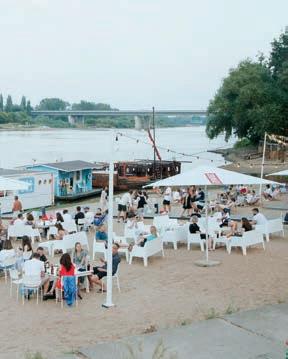
2 minute read
Defilad Going Green!
Five bids ranging from between PLN 61.2 million to PLN 73.3 million have been submitted as part of a competitive tender process that will decide which contractor redevelops Pl. Defilad. Once a winner is decided, the chosen firm will then have 60 weeks to execute the redesign as previously prepared by the AA Collective studio. Promising less concrete, the project will involve the planting of over 100 new trees, the introduction of thousands of shrubs and plants and, also, a water feature.
Set between the Palace of Culture and the Museum of Modern Art in Warsaw, the plans further envision lawns positioned exactly where tenements once stood before being pulled down to make room for PKiN. Pavements, meanwhile, will be laid where streets once stood.
According to City Hall, the surface of the new square will be covered by six types of stone, with different colors used to mark out former courtyard spaces and suchlike.
It’s A Miracle!
Previously famed for venues such as Cud Nad Wisłą (Miracle on the Wisła), the area around Płyta Desantu will see the return of gastro concepts this summer. Known as the heartbeat of the riverfront’s social scene, the disappearance of Cud Nad Wisłą in 2019 was taken as a body blow by Warsaw’s night owls and a sign that the city had uncomfortably lurched towards outright gentrification. Seen as a collection of cargo containers, few other places caught the hedonistic atmosphere better than Cud and its fellow operations. Now, following a decision by an evaluation committee, this Warsaw legend is set to be welcomed back on the proviso that noise will be closely controlled.

Transportation
Exhaust-ing Stuff
Despite moves to discourage car use, Warsaw now has more cars per resident than Berlin and New York…
City Hall’s campaign to ‘de-motorize’ Warsaw appears to have flopped after latest figures revealed that over 135,000 new vehicles were registered in the city in 2022 – nearly twice as many as the previous year.
Bringing the total number of registered vehicles to a whopping 2,139,666 (of which 1,617,498 were passenger cars), the data shows that Warsaw has around 850 cars per 1,000 residents – one of the highest motorization rates in Europe. According to Deputy Mayor Michał Olszewski, this compares to 300 vehicles per 1,000 inhabitants in Berlin, 240 in Copenhagen, 247 in Amsterdam and 246 in New York.
“Even assuming that not all vehicles registered here are actually driven in Warsaw, this still leaves us with one of the highest motorization ratios in Europe,” said Olszewski. Oppositions politicians have been quick to criticize City Hall in light of the revelations, with Marek Szolc slamming the Mayor’s pledges to cut traffic and increase public transport options as being little more than “a PR fairy tale”.
Since taking office, Mayor Trzaskowski has repeatedly promised to slash congestion and reduce the number of cars of the roads; as part of this, ongoing projects to create ‘a new center for Warsaw’ have made much of tactics aimed at making the city less car dependent. The issue, however, appears to be far more complex than initially thought.
Despite this, the findings are perhaps not as bleak as they seem. In their defense, City Hall note that, as things stand, their plans for ‘a new center’ remain very much a work in progress with several major arteries yet to be targeted. Moreover, despite the increase in car registrations, the number remains below the pre-pandemic level. Others, though, remain unconvinced with Councilor Szolc seizing the opportunity to remind the public that in January City Hall made a car the top prize in its first city lottery.








